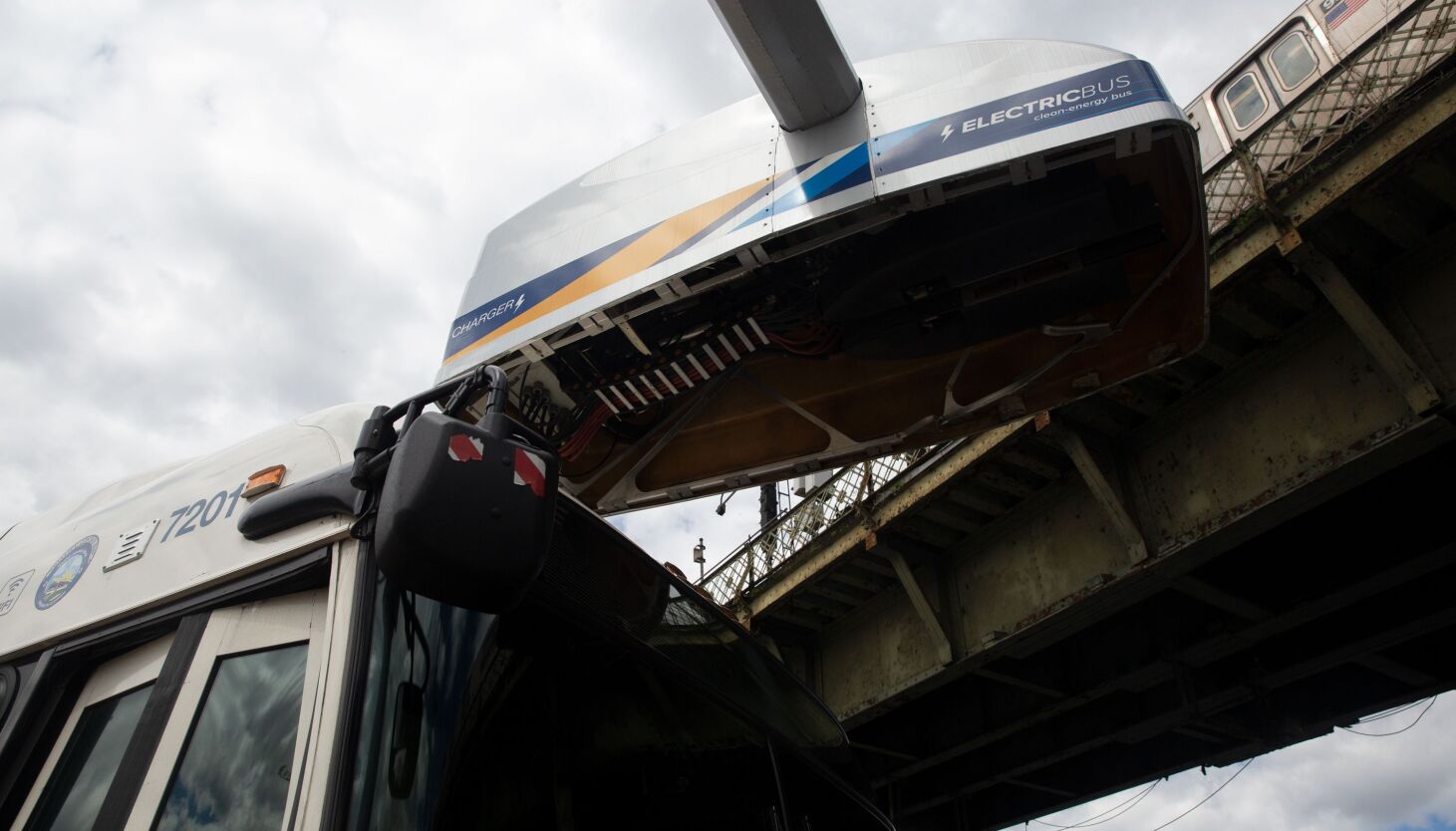The MTA’s surface fleet of nearly 6,000 buses is supposed to get a jolt of life with 60 more electric buses set to hit the streets sometime next year, but experts say the juice docks for the vehicles could be a liability.
While this adds four times the number of buses to the 15 electric buses currently in use, a new study suggests the on-street chargers that power these buses need more flood protections.
The study, published recently in the peer-reviewed scientific journal “Transportation Research Part D: Transport and Environment,” seeks to determine just how protected or unprotected the city’s current bus chargers would be during storms and floods of the kind that NYC has experienced this century. The analysisused flood prediction information from both NYC Open Data and the Federal Emergency Management Agency; maps of the B32 and M42 bus routes, which have electric buses in their fleets; simulations of random power outages, and the locations of current on-street charging stations.
In every scenario tested, one or both of the routes’ on-street chargers were compromised by flooding or power outages, contradicting the MTA’s belief that an East Side on-street charger in the study is not currently vulnerable to flooding.
In three of the more severe scenarios, in which floodwaters could top three feet, not only would the fast on-street chargers be compromised, but the maintenance that the chargers would need after being flooded — like using backup power generators, or needing to switch out bus batteries by hand — would cause delays on these two routes.
“I wasn’t totally surprised to see the depot would be flooded,” said Maya Tessler, a oceanography masters student at Louisiana State University. Tessler co-authored the report with Elizabeth Traut, an affiliate assistant research professor at Penn State University. “One would think they’d protect them. In the future, it would save them a lot of money if they did.”
Planning for Storms
The depots that Tessler is referring to are the larger buildings where buses are parked up for either charging or refueling, depending on the type of bus. Those depots, as a result of post-Sandy resiliency efforts, are supposed to eventually be flood-protected, but there is no time frame for when they will be completely protected.
But THE CITY reported in 2020 that many of them may not stand up to a strong storm, according to a report from the nonprofit Tri-State Transportation Campaign.
On-street chargers have so far not been as scrutinized.
The new study finds that, without flood-protected chargers, the MTA could lose $945,000 per day from loss of service on the B32 route from Williamsburg in Brooklyn to Long Island City in Queens, and another $10,400,000 per day from the M42 route, which cuts across Manhattan from West 42nd Street to East 41st Street.
Traut argued that long-term vision is necessary to combat climate change and the extreme weather conditions that come with it.
“Looking at the last 100 years is not enough. You need to look at the next 500,” said Traut. “You’ll save a lot of money, a lot of planning, and save a lot of lives.”
Solutions Exist
The study notes that solutions already exist, and could be easily implemented over time by the MTA, which faces a state mandate to electrify its entire fleet by 2040.
Potential fixes include having portable diesel generators to power stations, solar paneling, barriers around chargers, and swapping batteries out at stations during emergencies.
“One thing that people are interested in is new technology. [But] we can address climate change using existing tech. We don’t need new tech to solve this problem,” said Traut.
The MTA acknowledges that the West Side charger that supplies power to the M42 electric bus route is in a flood-prone area, and officials plan on testing flood barriers for that location, according to spokesperson Sean Butler.
But, Butler said, “given the location of the E. 42nd St charger is not flood-prone, it does not have any specific flood protection measures.”
Protecting Power Sources
According to the city comptroller’s recent report, “Ten Years After Sandy: Barriers to Resilience,” over $142 million has been allotted towards Department of Transportation efforts to make roadways and bridges more resilient, with nearly half of that money spent so far.
In April 2022, the MTA did a presentation alongside Gov. Kathy Hochul on its plans to convert its entire fleet, explaining that the amount of additional power needed would be around 370 additional megawatts — enough to light a small city.
Kevin Garcia, the transportation planner with the nonprofit New York City Environmental Justice Alliance, said that the MTA should make sure it is using renewable energy as it adds more electric vehicles.
“If they are seeking to deploy more on-street charging, going the route of building out flood barriers, building up solar panels around the street chargers can definitely help to improve their resilience,” he said. “Build out these chargers so they may be on higher ground or be on a platform that could potentially help make sure that these chargers continue to work during flooding events.”
Garcia noted the Albany passage of two bills, SB3535 and A3090, in the state Senate and Assembly related to the purchase of electric bus fleets across New York could make these resiliency efforts for on-street chargers more important to prioritize.
These two bills would ensure that by 2029, all buses procured by the state would need to be electric. The bill has passed the state Senate but has yet to pass the Assembly.
“I think the pandemic has really shown who continues to ride public transit, you know, when these national-global events take place. And what we’ve seen from the events of Hurricane Sandy 10 years ago, or Hurricane Ida, which was a little bit more recent, folks are still riding public transit, whether it’s a subway or buses,” said Garcia. “We want to make sure that this mode of transportation is still accessible and still operating so that folks can get home safely.”
Christine Kirchhoff, an associate professor of Law Policy and Engineering at Penn State University who was not involved with the study, said that the amount of carbon emissions the city would be preventing by continuing to add to their electric bus fleet while also protecting their on-street chargers from flooding is important given that we are not inundated with flood events “365 days out of the year, yet.”
“But, that’s coming down the road,” said Kirchhoff.
She also added that it’s wise for the city’s emergency management team to take community feedback into consideration, and to understand the importance of prioritizing certain protections over others.
“I think it’s hard to physically protect everything,” she said. “There’s always choices. Do we invest in the extra protections needed to protect every single one of these on street chargers, or do we balance that with protecting something else that may not be a high priority for residents in a particular area?”




